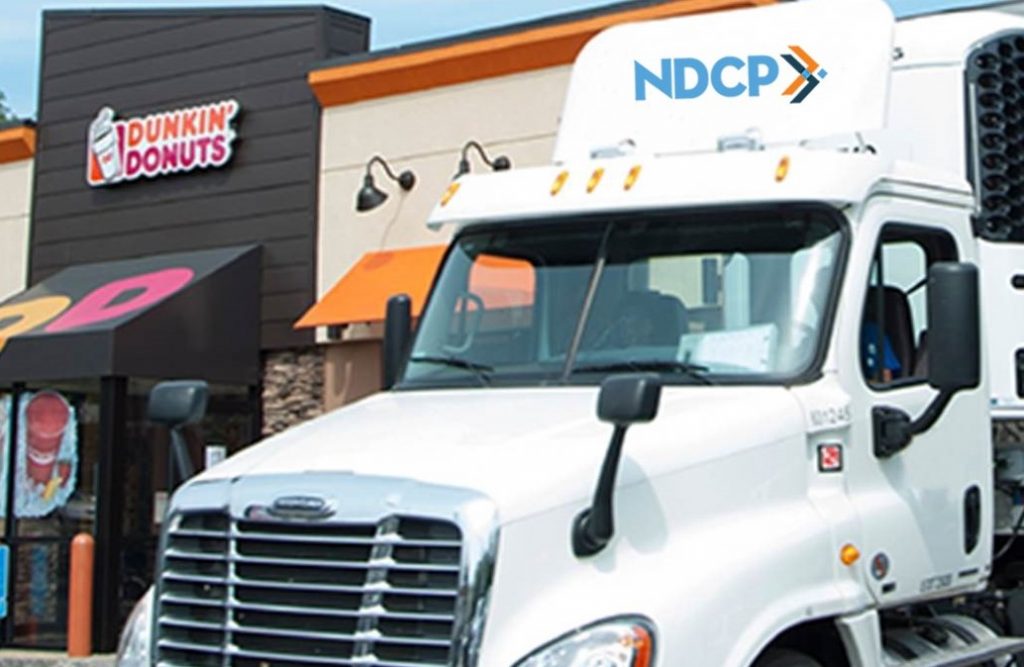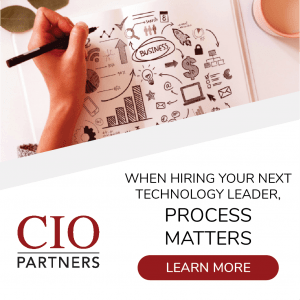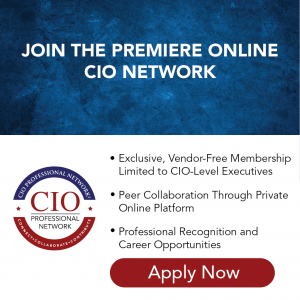Grant Shih serves as Chief Information Officer for National DCP, a $2 billion supply chain management company serving the franchisees of Dunkin’ Donuts and providing comprehensive business solutions to enhance the operations of nearly 10,000 restaurants and locations in 41 countries.
In this issue, Grant shared how pivots in his career path provided key opportunities to harness the greatness of technology through its application in varying environments. We also spoke with Grant about the growing importance of leaders setting clear expectations in an increasingly remote work world and how he has made an impact in narrowing the gender gap in STEM careers.
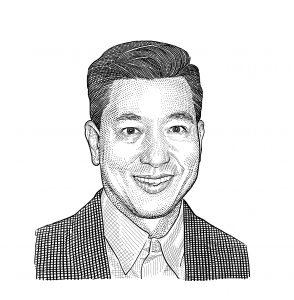
Chief Information Officer
National DCP
Walk us through your CIO path. How did you decide to pursue a career in technology, and how did you progress to your current organization?
I was born in New York, raised and grew up in California, and then attended the University of Georgia. I was a marketing major and thought that I would pursue the Don Draper Mad Men world. When I found that some of the key jobs for new marketing graduates were driving cigarette trucks and stocking shelves in convenience stores, it snapped me into reality. As life provides circumstances and chances, I happened to catch on with Accenture, though I knew nothing about consulting.
When I graduated, the world was prepping for Y2K, and technology was having a day in the sun. Even people who weren’t technical were suddenly wrapped up in the “what if” scenario of planes falling out of the sky, power and water not getting to homes, mass anarchy in the streets. So, some of my first consulting assignments were around readying the core infrastructure of utility companies for Y2K.
Through that experience, I quickly saw how important technology was, not just as cool new toys to play with but its importance to life at the fundamental level. I am grateful to have had the chance to step into very technical roles doing development, batch operations, and some major billing systems and to have been exposed to the modernization of legacy systems. I have had a multitude of opportunities that have spanned multiple technologies – some that were very cutting-edge at the time. More importantly, I was able to experience different industries in which to apply that technology. While my career started off in the utilities and natural resources sector, it quickly meandered through high-tech, communications, entertainment, government, retail, operations manufacturing, and more.
After 15 years with Accenture, I joined Carter’s OshKosh B’gosh. That was my first in-house experience within IT. My time at Carter’s was great. I got to see the inner workings of a major retailer, the structure of an IT organization, and the importance of being service-oriented toward the business. We thought through problems with a global distribution network and global manufacturing contracts to produce a product. From there, I sought out my first CIO role and was fortunate to join Encompass Digital Media.
This company was in a completely different industry and field. Going from baby pajamas to now streaming digital services like Amazon Prime was a big pivot – but I welcomed that pivot because it was another opportunity to see the greatness of technology through its application in different environments and scenarios.
CIO Partners was National DCP’s search partner for their next chief information officer and recruited me for my current role. I’m grateful to have now been at NDCP for about a year – an organization that has not only weathered the pandemic, but also social unrest, heightened political awareness around the world, and so many environmental concerns.
Would you consider yourself a CIO, a CTO, or a hybrid? Why?
Traditionally speaking, “CIO” connotates back-office – manage to a budget, keep system availability up, make sure that demand is being met. A CTO traditionally has been more focused on assets that can go to market, how a product-oriented view is pushed, and how to achieve adoption of the technology.
I like to consider myself a hybrid because I’ve always been focused on more than just technology. I would not necessarily enjoy an opportunity where it was so defined to be one or the other.
As much as we would love to focus on innovation and the aspects traditionally associated with that CTO role, you can’t do that with an infrastructure that’s aged or unreliable. You can’t do that without maintaining a healthy and productive staff or with ballooning costs. There are traditional responsibilities associated with the CIO title that are just as important but that don’t get the glory.
What initiatives have you overseen to date in your time with your current organization? What’s on the horizon?
I started at NDCP when the world more or less shut down and pivoted as a result of COVID-19. Therefore, one of the big initiatives we had was to navigate the entire organization – IT and beyond – through the response to the global pandemic, then figure out how we maintain an aggressive set of objectives despite the shift in landscape and assumptions.
We have also accomplished a great degree of infrastructure hardening – migrating servers and data centers into more reliable platforms. We hardened redundancy and eliminated single points of failure and modernized platforms. We consolidated extraneous systems into singular points of support.
In addition, we’ve pursued initiatives around our brand integration and being closer to the needs and wants of the everyday franchise owner and how they take delivery of our goods. We’ve achieved a higher degree of optimization within our warehouse processes – from the way we select product, to the way that we source it and take delivery of it, to how we tap a truck for optimal usage of that space, to how we keep things cool, how we make sure that our drivers can more efficiently deliver that product – not just on time, but also with proof of delivery.
As far as what’s on the horizon, with Inspire’s acquisition of Dunkin’ Brands, we could potentially play a whole different game around scale. While Dunkin’ is a huge franchise model, this in essence more than doubles the size, as well as the variety of product that we would love to have the chance to source and distribute.
Looking at the initiatives that we have planned around the brand integration and as we move to a more digital experience for our end users, we recognize that this is going to bring a higher degree of security concerns. We’ve all seen the ill effects of cybercrime in a number of areas and sectors. While it hasn’t necessarily been directed at organizations like NDCP, the services that we require – the Amazons, the Solar Winds – might be targeted. Therefore, we need to be more acutely aware of how to manage the risk of cybercrime with partners in our ecosystem.
Of course, we also want to address mobility, which is a driver of user experience. Really, all of our initiatives circle back around to redefining what that user experience in today’s world looks like and integrating closer to the end customer.
How do you foresee your organization being different in two years, and how do you see yourself shaping that change?
That’s a sophisticated question that requires a sophisticated answer. First, in the next couple of years, I believe there is going to be a shift in people’s perspectives. It’s not that technology is going to be less important, but I think the application of technology is going to be questioned a lot more.
There are too many social, environmental, and political consequences now of what we do with technology that the everyday person is going to have to confront. The rush to get cooler tech out to market and in the hands of people may end up pulling back a touch because there are bigger ramifications of releasing that information. AI is a good example. If we don’t have the right controls around AI, that can lend itself to a very scary future.
Organizationally, it’s going to be about surrounding yourself with people and partners who have an appreciation of both the positive and potentially negative ramifications of every technical decision that we make.
What new or disruptive technology issues or emerging trends do you think will impact your industry in the future?
We’ll get more evolved with sensory-based technology, whether it be sight, sound, smell, touch – everything that goes beyond reading something off of a screen. For example, we are testing our trucks outfitted with 360-degree cameras that could record massive amounts of data to be used for safety reasons.
Automation in warehouses is nothing new, but there’s going to be some new technology that will make scanning and inventory management easier. We’ve had RFID and those types of technologies for a long time, but as they continue to get better, they’ll be more ubiquitous within lower margin, higher throughput environments. There’s an easy business case for Tesla to inventory its parts because they’re expensive, but cans of coffee or packets of sugar are harder to justify. But the trend is that we’re going to figure out a way to dilute that cost sufficiently.
Share your thoughts on the availability of IT talent. What strategies do you employ, and what’s different in your organization?
I’m not down on the availability of IT talent, but I do think there is a growing gap between people who think they have what it takes to be successful and those who actually have the skillset. There seems to be a sense of masking through skills. However, it comes down to basic communication skills, and the norm set around remote work – and, at times, abstraction of the human connection – is going to become evident in the availability of IT talent. Some of our best thinking is still done in a group environment with open, candid discussions. In a world where that’s becoming less the norm, we’ll likely see an erosion in some of the interpersonal and communication skills that are so key for true advancement and innovation.
In a remote work environment, the advantage may go to the person trying to put on a show or hide things because they now have a natural barrier allowing it to persist. As leaders, we have to be conscious of that and be intentional about seeking time with our talent to set expectations, not just on aptitude, but have attitude-related conversations. We must be intentional, direct, and clear as to expectations on how each team member must help the team’s progression, self-motivation, and finding answers without a hallway to walk down to initiate collaboration.
When evaluating talent, we must shift away from aptitude and certificates and degrees from fancy colleges, and even experiences, and into attitude and a sense of personal and professional fulfillment through our work.
What traits and attributes are essential for today’s CIO versus 10 to 20 years ago?
People management has come to the forefront exponentially. Today, we’re not asking “could it work?” but “should it work, and to what end and to what purpose?” This relates to the need to take responsibility for decisions – with technology but also people.
It’s important to recognize that the members of your team are more than just assets. They are people who have elderly parents at home, have kids struggling with digital learning, have their own career aspirations. A CIO or CTO who overlooks that and focuses just on the technical solve is not going to be successful because they’re going to lose that talent to someone else. Advances in technology have allowed the barrier to entry for most things to be reduced, including location. We’re no longer just holding onto talent versus other IT shops but against all the other careers that have gone digital.
The other trait for today’s CIO/CTO is honesty about capabilities, needs, and weaknesses. Everywhere I’ve been, I have tried to put together an objective menu of services for my business colleagues and counterparts. This menu contains quadrants that identify strengths and weaknesses against the value to stakeholders. The sweet spots for change are the two quadrants where you’re really good at something but no one cares, or you’re not that good but it’s something that your organization desires. These are where a CIO or CTO should focus. Let’s not continue to invest in an area where we excel but the business doesn’t need. On the other hand, if the business requires a capability that we can’t currently provide at the optimal rate, then we must admit the weakness, identify the solution and be willing to make the investment to execute it.
What advice would you give for someone who aspires to be a CIO?
So many people look for the answer in this path as a checklist. I would challenge them to reframe that thinking. First, don’t define it as things that are necessarily measurable. It’s not about getting certificates, it’s not about going to a data brief. Those are all good experiences, but at the end of the day, it’s not about the technical search. It’s not about how well you can code in something or how well you know an architecture and can design cloud strategies. It’s about understanding the relative importance of those things, when to apply them, and the ramifications. You must also identify and understand your endgame. Are you trying to just be a CIO or CTO? Once you get there, are you like a dog chasing a bumper? What do you do when you catch it?
How do you decompress from the challenges of your current role? What do you do for fun?
Over time, I’ve recognized more and more the value of spending time with family and having hobbies. I love to travel. I love food. My fiancée, Ally, and I love to see the world – to experience different places and cultures, experience different foods. Experience over stuff is our mentality. I enjoy being active and outdoors. I like to play golf, and a recent trip to Colorado reaffirmed my love of being on the mountain on a snowboard. I also enjoy woodworking and carpentry and coaching my kids’ sports teams.
Who have been your biggest influences, and why?
My parents have given me a good model of patience and hard work. I’m not afraid of hard work as long as it’s congruent with what I believe in and I’m not squandering resources. They instilled in me an appreciation of what I have and what to do with it. As I’ve gotten older, I value that lesson more and more.
My fiancée is the love of my life, and our kids keep me grounded. They’re my motivation. I enjoy working so that I can provide for them and share experiences with them.
I’ve had a lot of professional mentors as well. I’ve gained perspective and learned from many, many people who I’ve either worked for or with and I’ve learned a lot from the people who have worked for me.
Which books have you gifted the most over your career or do you recommend?
Along the lines of the earlier decompression question, I prefer leisure reading and like Dean Koontz’s novels. I have learned people are busy enough, so I don’t assign books to my team. However, The Goal: A Process of Ongoing Improvement, by Eliyahu Goldratt, covers excellent management concepts. I would also recommend biographies and organizational origin stories – the Elon Musk story, for instance.
If you weren’t doing the job that you have today, what would be your alternative dream job?
Clearly, the starting shortstop for the Atlanta Braves! I would have loved to have had a professional athlete career path, but that just wasn’t in the cards. I held my own in a number of sports, but wasn’t the 1A option. If I had the physical ability, that would’ve been fun.
What would you want our readers to know that we haven’t covered?
Inspired by my daughter – and to do something about the gender disparity in STEM careers – I am proud to say that I created a nonprofit organization called the IT Girls Foundation. We run before-school programs teaching STEM topics and the challenges that arise in a career in STEM and how to navigate them. We take students through multiple technical and business concepts, such as simple and compound interest, cloud computing, and cybersecurity. Before the pandemic, we also took field trips to STEM companies or events.


